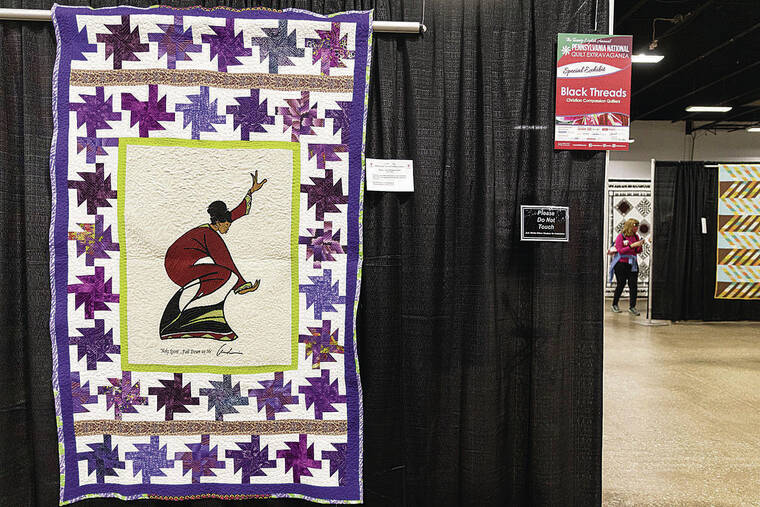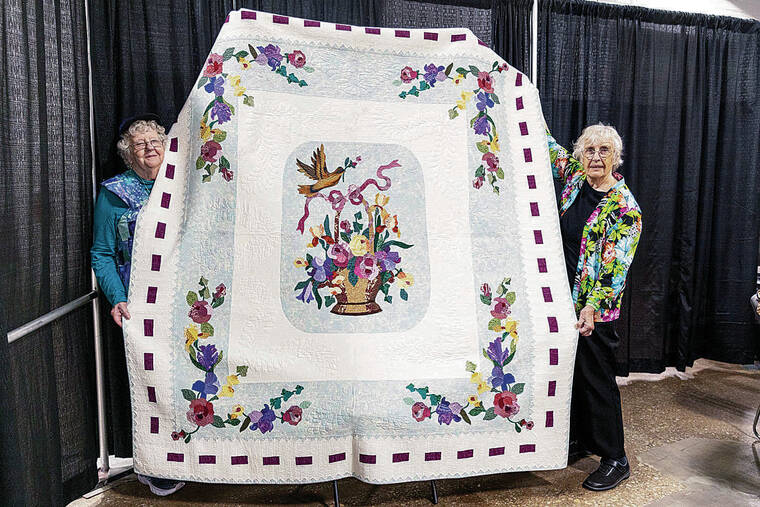Extravaganza of quilts was on their bucket list

PHILADELPHIA INQUIRER / TNS
“Rejoice,” a quilt by Joye Hollingshed, hand-pieced by Alice Hollingshed, and machine-quilted by Sheila Colson, was showcased in the “Black Threads” exhibit at the Pennsylvania National Quilt Extravaganza. The three women are members of the Compassionate Christian Quilters in West Philadelphia.

PHILADELPHIA INQUIRER / TNS
Beverley MacGown, right, and longtime friend and fellow quilter Jean Donahue, both of Concord, N.H., hold up MacGown’s quilt “Baskets & Butterflies” during the Pennsylvania National Quilt Extravaganza at the Greater Philadelphia Expo Center in Oaks, Pa. The quilt won a blue ribbon at the 2004 Vermont Quilt Festival.


OAKS, Pa. >> When “Baskets & Butterflies” was unfolded and could be seen in all its glory on the Pennsylvania National Quilt Extravaganza stage, master quilter Beverley MacGown’s handiwork got a round of applause, and so did she.
“It’s such an honor,” said MacGown, 86, who sat in the audience next to her friend, neighbor and fellow quilter Jean Donahue, 81. “This is the biggest quilt show I’ve ever been in.”
The two widowed grandmothers traveled from Concord, N.H., to the Greater Philadelphia Expo Center in September, courtesy of My Jump, a nonprofit that grants bucket list wishes to older Americans.
A blue-ribbon winner at the 2004 Vermont Quilt Festival, “Baskets & Butterflies” was brought on stage as a surprise for MacGown and Donahue during the 28th annual Pennsylvania event. The show, one of the largest of its kind in the country, was canceled last year due to COVID-19.
Despite smaller crowds than seen in years past, when as many as 8,000 people attended, the vibe at the center was as exuberant as the 600 quilts on the walls. Quilters, a majority of whom are women of a certain age, are a sociable lot.
A survey released in 2020 by the Craft Industry Alliance estimated that quilting is a $4.2 billion annual business in the United States, where between 9 million and 11 million people, 98% of them female and 65% retired, are active quilters.
Don't miss out on what's happening!
Stay in touch with breaking news, as it happens, conveniently in your email inbox. It's FREE!
“Quilters are very giving. They’re willing to help each other and share information,” said Eileen Mannion, 66, who stitches large quilts for customers at her Quilting Solutions business in Sewell, N.J. “It’s inspiring to see all these quilts up close, rather than on a screen.”
At the event, quilts were arranged like paintings in a gallery. Handmade quilts, machine-quilted quilts and long-arm quilts — some stitched on computerized machines — were displayed with title cards.
Some quilts took on political or pop-culture subjects, such as Joe Biden and Elvis Presley, respectively.
An exhibit titled “Black Threads” included two dozen quilts created by West Philly’s Christian Compassion Quilters.
The show abounded with color, shape, texture, exquisite detailing and precision craftsmanship, and drew much admiration.
“I watched the spectators pointing and saying, ‘Ooh, look at that,’” said Joye Hollingshed, a co-founder of the 30-member Christian Compassion group, which has been gathering for nearly 20 years at a church with the same name.
“It’s just so wonderful to know that people enjoy our work,” said Hollingshed, 91, who created the exhibit’s signature quilt, “Rejoice,” which was based on a painting by Andre Thompson that depicts a stylized (and stylish) Black woman during a moment of praise and worship.
Sheila Colson, a retired educator who has been a Christian Compassion quilter for more than a decade, noted that Black quilters embody a tradition that has roots in slavery and struggle. Quilts made by Black women from scraps of old clothing often became heirlooms that testified to a family’s resilience.
“Quilting can keep the history of our ancestors alive,” said Colson, 63. “African Americans should know our history. Every piece of it, down to the quilting.”
Stitching layers of cloth together for warmth, either as garments or bed coverings, probably originated in the ancient Middle East and developed centuries later in Europe. The practice of collaborative quilting, or “quilting bees,” began after 1800 in the United States and became identified with Amish and other rural American communities.
A 1969 New Yorker magazine story about the rich tradition of quilting among Black women in Gee’s Bend, Ala., drew national attention and helped the craft gain recognition as folk art and, eventually, fine art. In 1991 the National Quilt Museum opened in Paducah, Ky.
The pandemic-induced shift from in-person quilt-making sessions to Zoom has been deeply felt across the quilting community, where the social aspects of quilting with others can mean a lot, especially to seniors.
The pandemic’s impact also was reflected at the show, where “Quarantine Quilts” was the theme of an exhibit by the Main Line Quilters.
“People had a lot of time, obviously, and they made really intricate quilts,” said member Abra Perrie, 48.
Perrie herself stitched an intricate, colorful piece.
“The concentration needed in creation of this quilt allowed me to briefly escape from the stresses of pandemic quarantine,” she wrote on its title card. “The bright colors of the fabric made both my children and me a little happier during the early dark days of the pandemic.”
Other quilts at the show made strong social and political statements. The Philly Pie Chart quilt, by the Philadelphia Modern Quilt Guild, was one. It reimagines a map of the city as chunks of vividly hued fabric, hand-embroidered around the edges with phrases such as “end homelessness” and “reform police.”
Kevin Devine, 51, president of the guild, is among 2,800 members of the Men Who Quilt group on Facebook. He said the quilt arose from Mural Arts Philadelphia’s “Stitching Our Futures” project, which was centered around “reenvisioning” the city budget.
MacGown and Donahue — who was hard to miss in her sparkling cobalt cap — got a bit of celebrity treatment as a video crew and photographers followed them at the event.
Webb Weiman, a veteran television producer for “Project Runway” and other shows, founded My Jump in memory of his father.
“We believe there are no bad bucket list items,” said Weiman, noting that one wish, fulfilled, came from a woman who wanted to learn to drive a tractor-trailer in memory of her husband. Next up: two women who want to visit Shenandoah National Park in an RV.
For MacGown and Donahue, the trek to the extravaganza was great fun. But for these women, quilting goes much deeper: It is part of their very identities.
“I can ‘read’ a quilt, meaning I can look at a quilt and figure out how it’s made,” said MacGown.
As do many quilting communities, members of their Concord group donate some of their work. There are always people who could use a quilt, the women said.
“Every family should have a Christmas quilt,” said Donahue.
After the big trip, what was in store for the duo?
“We’ll take a look at our fabrics,” said Donahue, “and start something new.”
———
Read Beverley McGown’s quilting blog at MissMollyQuilts.com.



